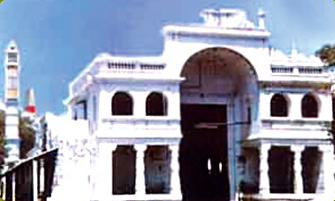 The Pottalpudur Dargha is located in the Indian state of Tamil Nadu. More specifically, this dargha is situated in the district of Tirunelveli. Pottalpudur Dargha was erected in the latter half of 17th century. More specifically, the year of establishment of this dargah is known to be 1674 A.D. This Dargah was constructed following the architectural style of the Hindu temples and is revered as a famous pilgrimage site. Local community considers this dargah to be no less sacred than the Nagore Dargha and next to Baghdad. This dargha is considered to be the oldest dargah of Tirunelveli district.
The Pottalpudur Dargha is located in the Indian state of Tamil Nadu. More specifically, this dargha is situated in the district of Tirunelveli. Pottalpudur Dargha was erected in the latter half of 17th century. More specifically, the year of establishment of this dargah is known to be 1674 A.D. This Dargah was constructed following the architectural style of the Hindu temples and is revered as a famous pilgrimage site. Local community considers this dargah to be no less sacred than the Nagore Dargha and next to Baghdad. This dargha is considered to be the oldest dargah of Tirunelveli district.
Rituals of Pottalpudur Dargah
It is important to note that many customs of the Pottalpudur Dargah are similar to the rituals followed by Hindus. In Pottalpudur Dargah, holy ashes are gleaned from the bark of the tamarind tree and ghee (also known as clarified butter) and flowers called nerchai are handed out to devotees. The lebbais are known to function as priests for the performance of the rituals in this dargah.
Communal Harmony and Secularism Promoted by Pottalpudur Dargah
Pottalpudur Dargah is considered to be a wonderful specimen of secularism and communal harmony. This is because it welcomes not only muslims, but also people having faith in other religions. They are the Hindus and Christians. This dargah thus boasts of being a place of worship for considerable number of Hindu and Christian pilgrims.
Festival Celebrated in Pottalpudur Dargah
Pottalpudur Dargah is known for the celebration of a festival called Kanduri Festival. It is celebrated during the months, July and August. It is a very popular and revered festival of this dargah. People of different religion come to this dargah during this festival. If their prayers are answered they pay their offerings. This festival is associated with the performance of a ritual. In a pot, sandal paste is prepared and then sent to the village of Ravanasamudram, which is considered to be a Hindu village. Then the paste is brought back from the village to this dargah with great splendor. The sandal paste is offered to Andavar, after which it is distributed among the devotees. The Andavar Festival is celebrated in this dargah similar to its celebration in the local Amman temples by many pilgrims. They are known to sacrifice the fowl and sheep in the dargah. Some people also bring fruits in lieu of live animals to celebrate this festival.
Related Articles:
Mosques in India
Indian Regional Temples
Churches in India
Gurudwaras in India





















